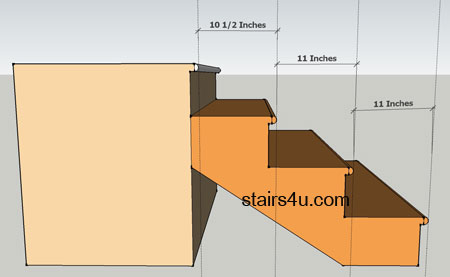Maximum Stair Tread Measurement Variation

The maximum stair tread measurement variation cannot exceed 3/8
of an inch between the smallest and largest step.
Example 1: 6 Step Stairway
1 - 11 inches
2 - 11 1/8
inches - largest step width
3 - 10 7/8 inches
4 - 10 3/4
inches - smallest step width
5 - 10 7/8 inches
6 - 11
inches
Then you would be okay because the smallest step
is 10 3/4 inches and the largest step is 11 and 1/8 inches and
the variation between the two does not exceed 3/8 of an inch.
Example 2: 4 Step Stairway
1 - 11 1/4 inches
2 -
11 3/8 inches - largest step width
3 - 10 15/16 inches
4
- 10 7/8 inches - smallest step width
The stairway
wouldn't meet these building code requirements, because the
difference between the smallest step and the largest step is a
half-inch and exceeds the maximum of 3/8 of an inch.
Reference: 2012 International Building Code - 1009.7.4 page 254

Here's a stairway without any nosing or undercut and equally spaced stair steps. Stairway treads or steps without nosing or undercuts can be measured from face of riser, to the next face of riser or from the front of the stair tread, to the back of the stair tread.
Attention: Don't forget to check with your local building department to verify any building codes on this website. This information could be incorrect or outdated. Building codes are updated regularly and to some building departments have different interpretations for certain building codes.

